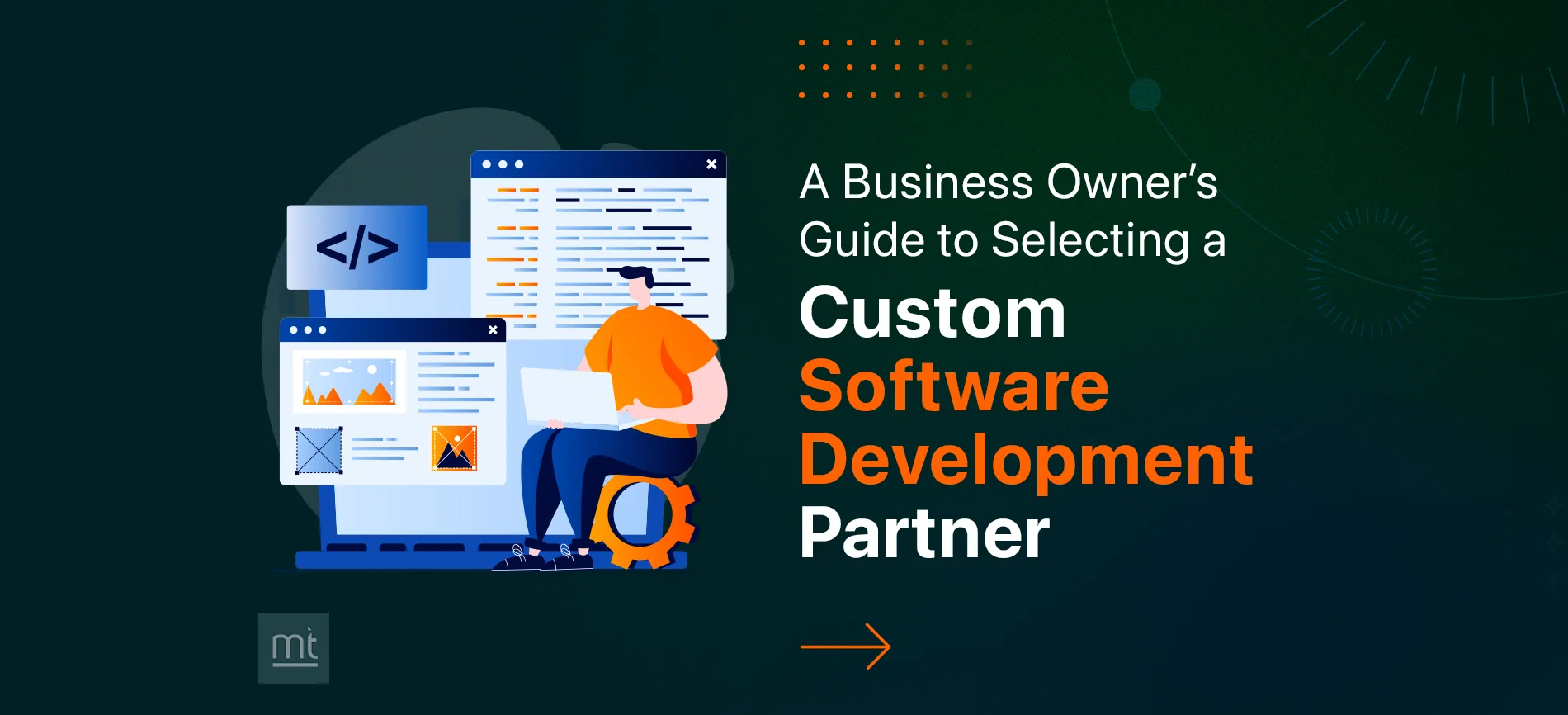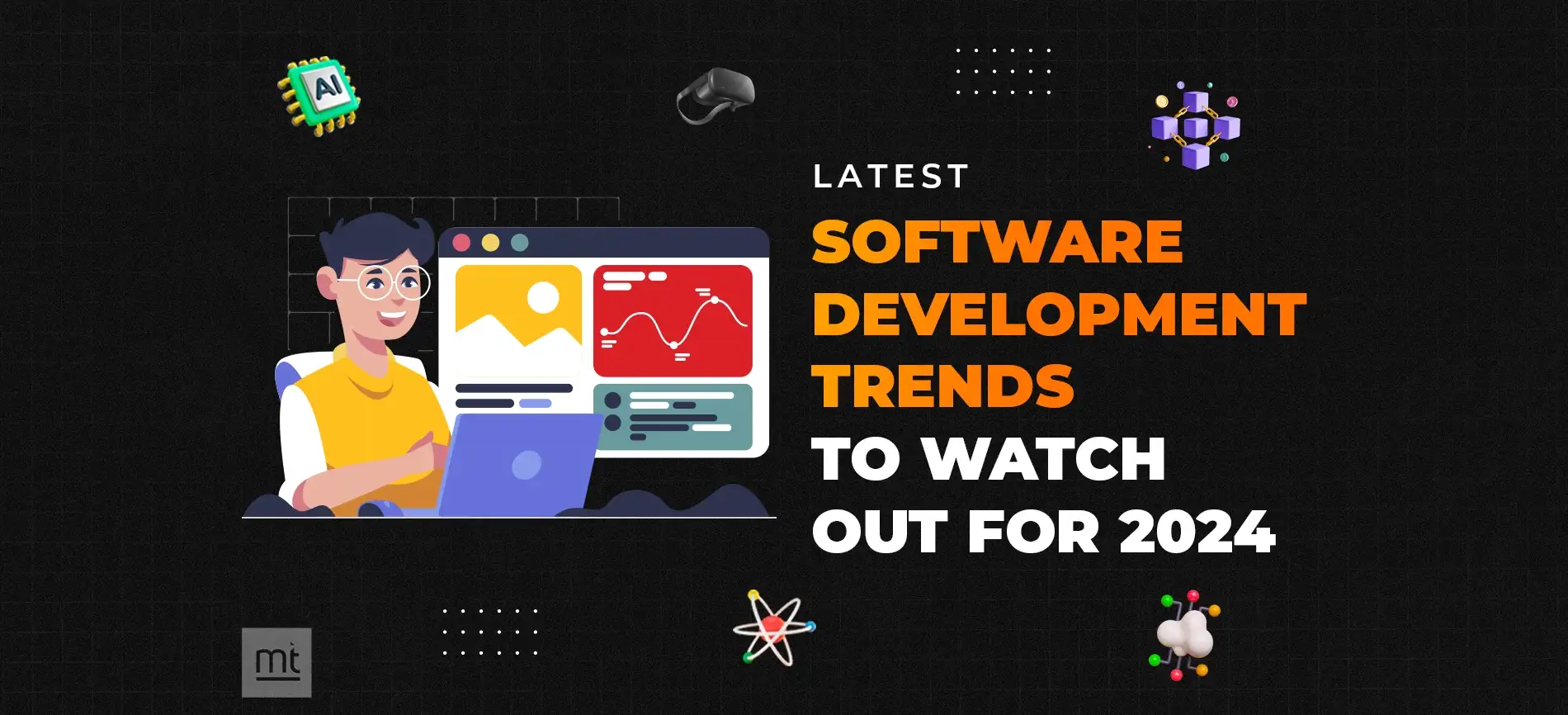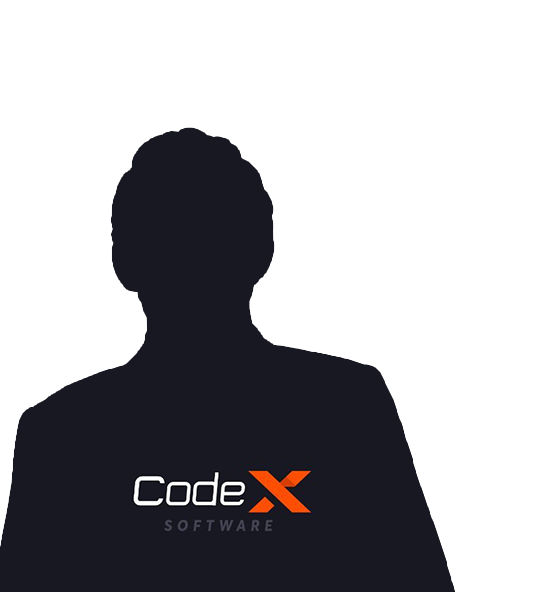Get 40 Hours of Risk-Free Development, Try Before You Hire. Click Here to Claim Now
Introduction:
Do you have software in mind that can help streamline processes or operations? It might be a pathbreaking CRM tool, an ERP solution for your business, or something else. When you decide to build a software product, the first dilemma that software developers will face is the suitable project management methodology.
Developers must choose an approach streamlining the development process, enabling high-quality outcomes while saving time and effort.
There are two popular software development approaches to compare for your project.
- Agile Methodology
- Waterfall Methodology
When you compare Agile vs Waterfall, you must compare the difference between Agile and Waterfall, risks, benefits, used cases, and how they work in real-time scenarios.
This post discusses power-packed software development approaches that can help quickly build robust, feature-rich software.
As a project manager, you must understand both approaches in depth to choose the one that perfectly aligns with your project requirements, resources, and the needs of the software development team.
What is A Waterfall Approach?
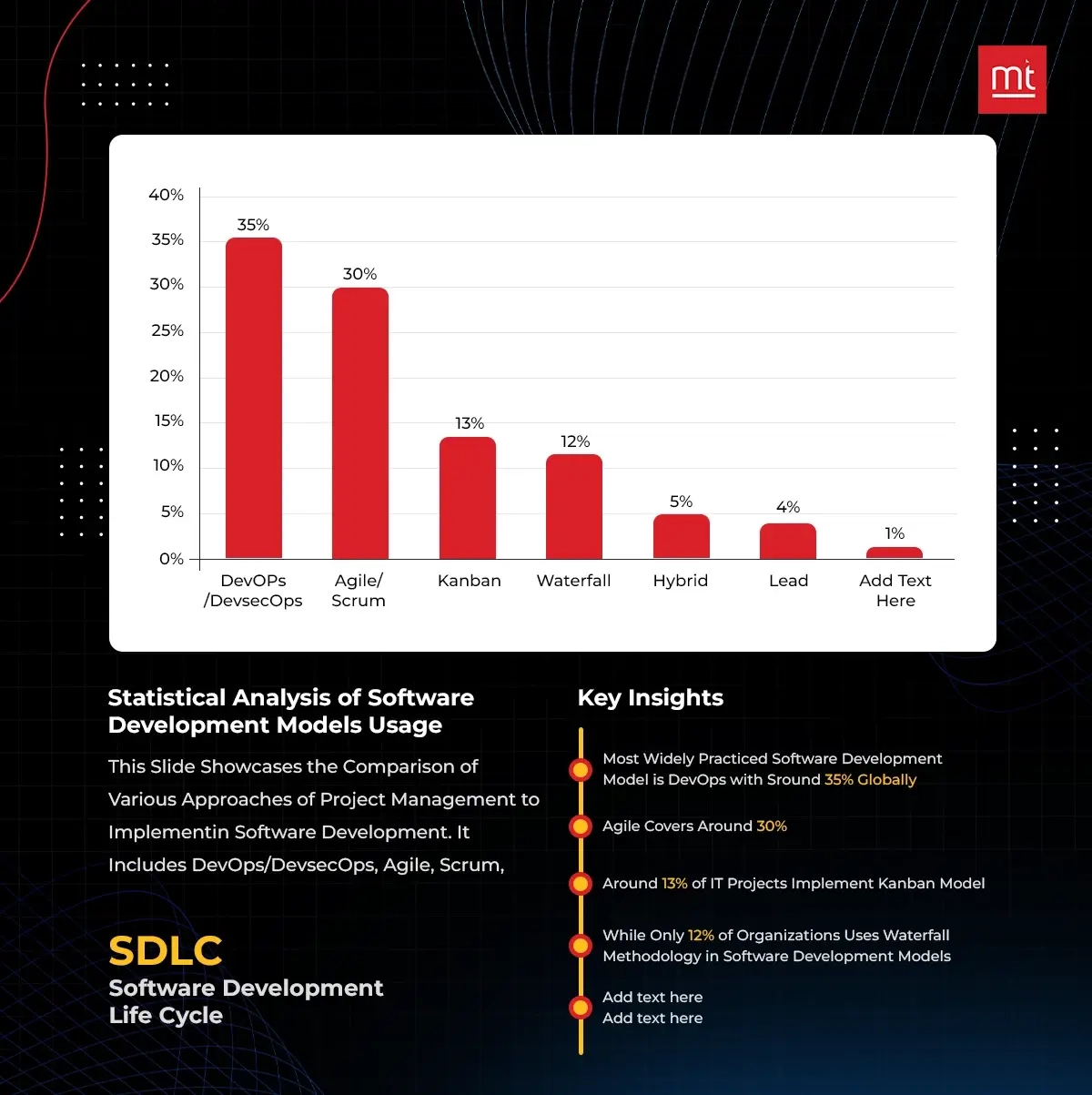
The Waterfall approach is a linear, step-by-step software development approach for building high-quality software products. It is ideal for project management if your project has a steady, clear scope and predictable timeline.
The project is divided into multiple phases and works top-down. The results are reviewed once the first phase is completed before work starts on the second phase. This approach is also called a Linear-Sequential Life Cycle Model.
The Waterfall consists of rigorous planning and execution. Developers must plan everything to ensure the project stays on track and is delivered on time. It also has five stages.
1. Initiation: All stakeholders brainstorm ideas in this stage and discuss project requirements and scalability goals.
2. Planning: Developers will sit with other stakeholders to discuss the tech stack, features, functionalities, and other crucial project aspects.
3. Execution: The actual development phase will start. Developers will build the software product's front and back end with all its features and functionalities.
4.Testing: Once the product is developed, quality analysts will test the app thoroughly to catch errors, bugs, or functional issues. If they find any, they will report them to the developers.
5. Closing: Once the testing is done, software can be deployed and launched with the right marketing strategy.
Benefits of the Waterfall Methodology
Let's check out some pros and cons of the Waterfall methodology in detail.
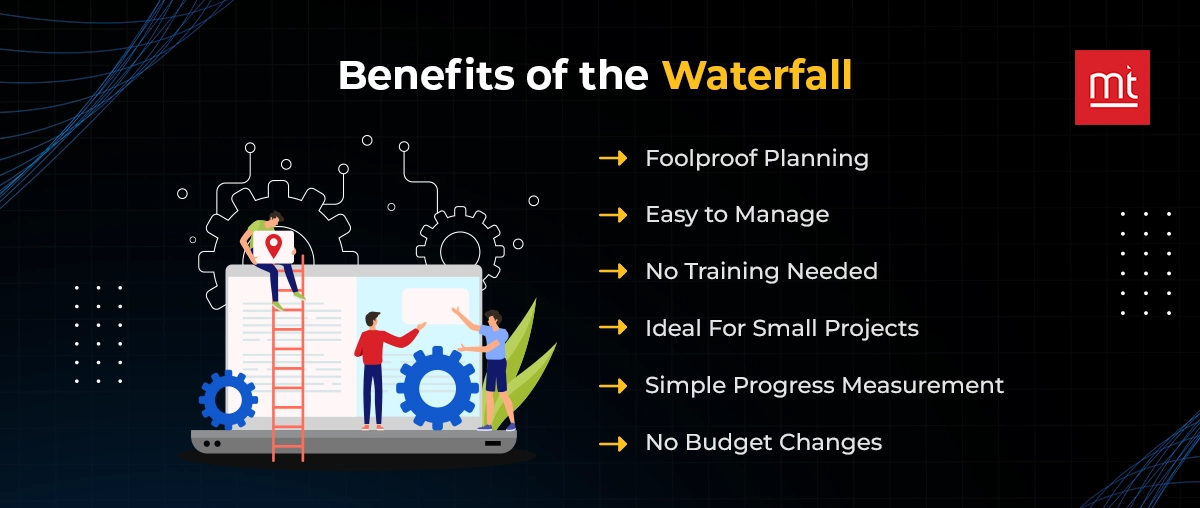
Foolproof Planning
Developers know what will happen at each stage of software development, as this approach requires extensive planning at the beginning of the process.
Easy to Manage
Compared to the Agile, this approach is simple, straightforward, and easy to manage.
No Training Needed
You don't need any training to start working on the Waterfall model. Even a beginner can start working on software development immediately.
Ideal For Small Projects
The Waterfall model is ideal for small projects with limited scope and simple requirements.
Simple Progress Measurement
As the beginning and end of the project requirements are pre-defined, it is easy to measure development progress.
No Budget Changes
Developers estimate the budget before the project starts. As the costs are calculated earlier, there will be no increased costs.
Limitations of The Waterfall
Waterfall is not a foolproof approach. It has some limitations as well. Let’s check out some of them.
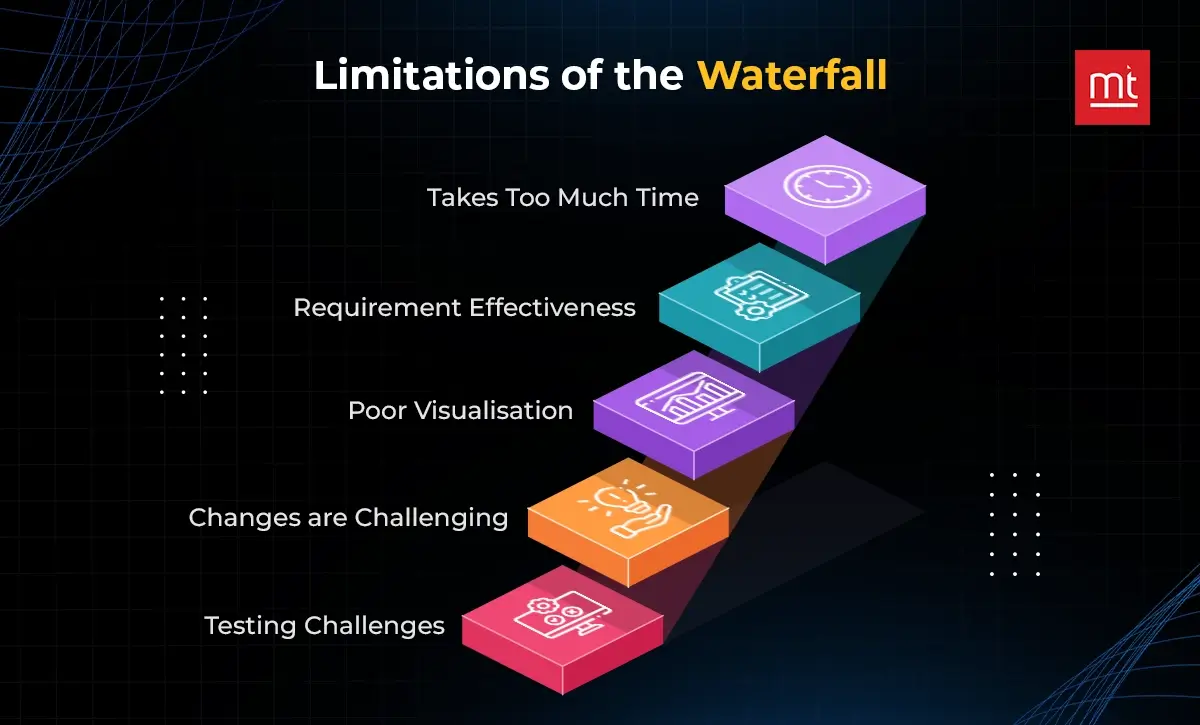
Takes Too Much Time
From requirement gathering to step-by-step development, this process is time-consuming.
Requirement Effectiveness
All the project requirements must be updated with the customers in the initial phase, which might intimidate customers. The approach asks developers to provide even micro details to customers before the project starts.
Poor Visualization
Unlike agile, customers cannot visualize the project through a requirements document. Wireframes may help, but end-users will struggle to put everything together to visualize the final product.
Changes are Challenging
Once the second phase starts, you cannot learn about mistakes or errors. Hence, it is challenging and time-consuming for developers to return to the previous phase and address errors and other issues. It takes more time, and the delivery might be delayed.
Testing Challenges
Waterfall only allows testing once the development phase is over. This will delay the whole project, as it is challenging for developers to identify and address issues in the later phase.
How Does Waterfall Work?
You must know how does Waterfall work. Waterfall follows a top-down phase model in which developers start the second phase once the first phase is over. This software development approach has only one direction. Furthermore, developers must write extensive documentation to streamline the process.
Once the first phase is over, developers review various aspects of it, make necessary changes, and start the second phase. As the name suggests, this is a very linear, top-down approach.
Waterfall Approach Principles
Here is a list of Waterfall principles:
- The project is divided into different sequential phases followed by a top-down level.
- This approach requires detailed documentation. From design to prototypes to testing, developers meticulously document everything.
- Customer involvement is minimal compared to Agile.
- Developers can start the next phase only when the previous phase is entirely completed.
What is the Agile Development Approach?
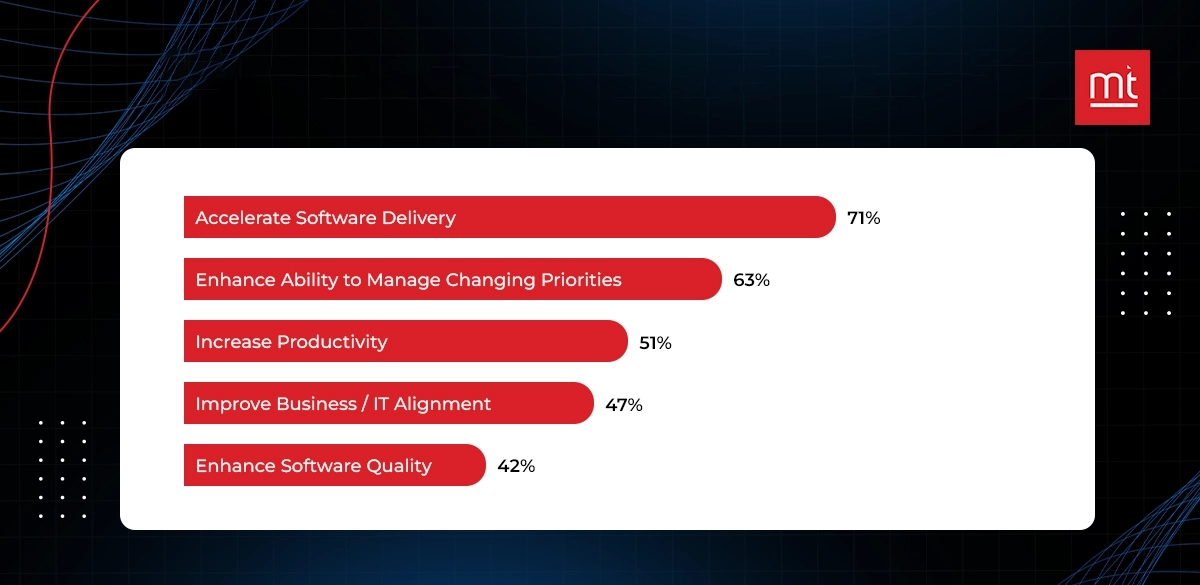
The agile development approach is relatively new and highly popular among software developers. It was developed to address some rigid issues faced by developers with the Waterfall approach.
A study shows that adopting a strong agile culture will increase commercial performance by 237%.
Agile development is all about continuous iterations of software development and testing throughout the software development life cycle. It is one of the most talked-about software development trends in recent times.
The project manager divides the development process into sprints, each with a defined duration and deliverables. The best thing about the agile approach is that customers can participate in it. Here, developers must produce and share daily reports and sprint demos that the team can review.
Expect high team engagement, collaboration, and rapid delivery of all the functional components. The agile development process can be divided into five cycles.
1. Initiation: As the name suggests, this stage is all about project initiation. Here, different teams brainstorm ideas, define product goals, discuss project requirements, understand end-user requirements and expectations, and prepare a requirement-gathering document.
2. Planning: In this stage, developers discuss the technology stack, project development approach, testing methodologies, etc.
3. Development: The development stage divides the project into multiple sprints and allocates teams for each sprint. Here, each sprint has different deliverables and purposes. The development team will follow an iterative approach to build a product in small increments. Remember that development and testing go side-by-side in the iterative approach.
4. Release: Once the software is developed and tested thoroughly, it is released to a small group of end-users for beta testing. Depending on their business objectives and goals, a project owner can release it immediately.
5. Retirement: This stage is about updating the existing version with new features and functionalities from time to time to engage users and improve the efficiency and productivity of the product.
What Are The Benefits of the Agile Approach?
Before finalising, you must discuss the pros and cons of agile methodology. Let's discuss.
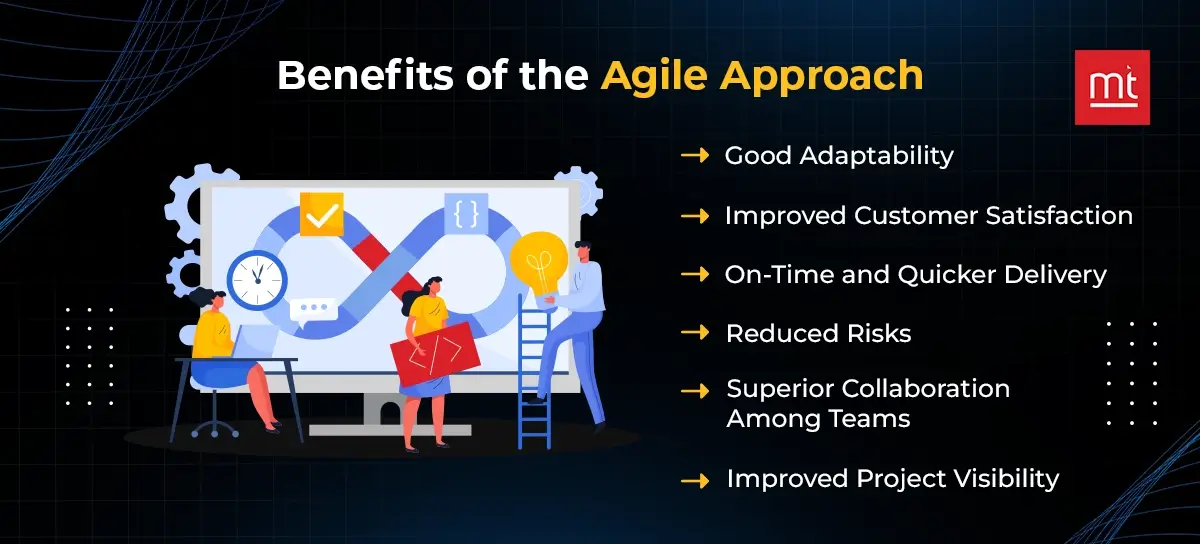
Good Adaptability
The agile software development methodology strives for change. The project is divided into multiple sprints, so developers are highly adaptive to new changes and environments. Agile development is best when developing software with evolving requirements or uncertain market conditions.
Improved Customer Satisfaction
The best part of the agile approach is that customers can expect to be involved throughout the process. Customers can submit feedback regularly to ensure the final product meets their expectations. Such participation in the process leads to better customer satisfaction and user-centric outcomes.
On-Time and Quicker Delivery
The short-sprint concept helps developers quickly build error-free features and functionalities. It reduces the time from app to market and gives businesses a competitive edge.
Reduced Risks
The agile approach iterates testing from the first phase of development. Developers can identify and address errors and bugs earlier to reduce risks. Also, early issue detection reduces the costs.
Superior Collaboration Among Teams
Agile development fosters healthy and quality team collaboration to deliver feature-rich products on time. Team members can take ownership of their work to provide the best outcomes. It will also lead to increased efficiency and productivity.
Improved Project Visibility
Regular review meetings and sprint demos offer a clear view of the project's direction. Stakeholders can review the project's progress and make timely decisions to ensure streamlined processes and operations.
Limitations Of The Agile Approach
Now, let's check out some of the limitations of the Agile approach.
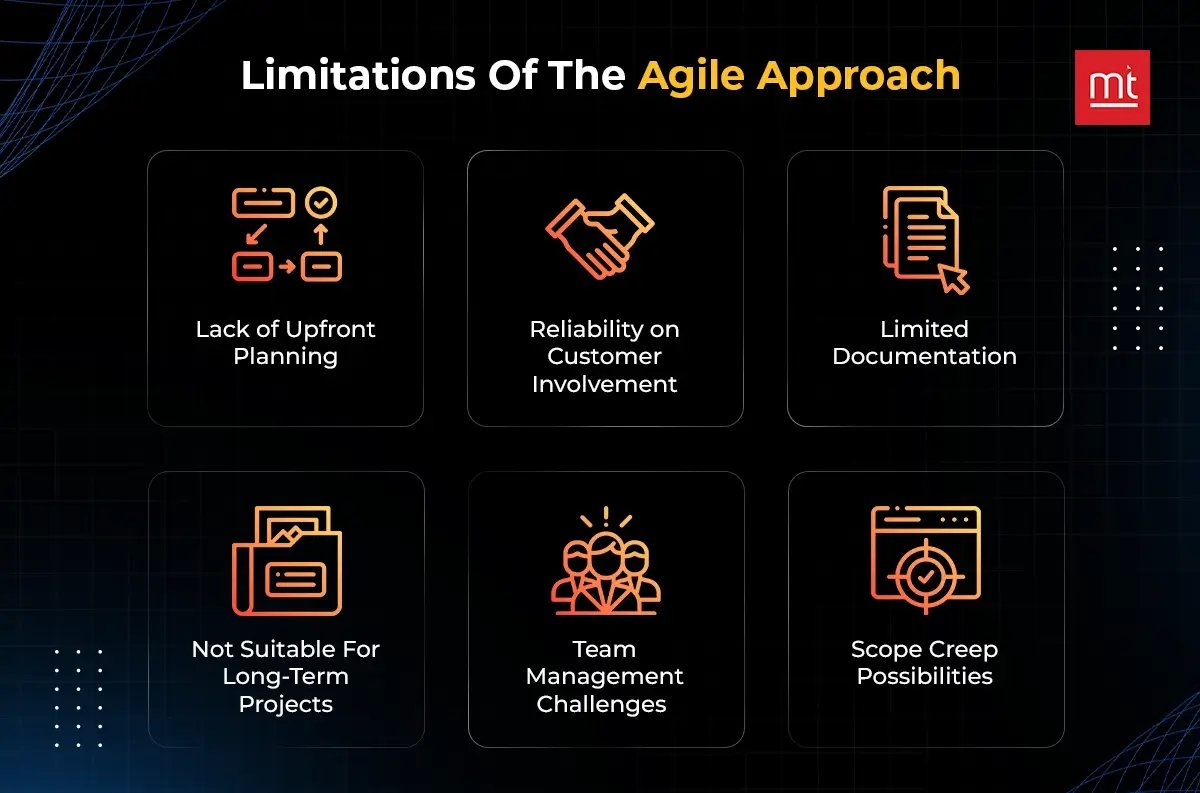
Lack of Upfront Planning
Though the Agile development approach is highly flexible, it might need some help, like upfront planning. Stakeholders might fail to predict project costs, timelines, and requirements accurately.
Reliability on Customer Involvement
The involvement of customers is crucial throughout the development process to make an agile approach successful. It might affect the development process if customers fail to provide clear feedback.
Limited Documentation
Agile development does not require extensive documentation. However, if new members join a project midway, it might be challenging for them to understand the requirements due to the lack of documentation.
Not Suitable For Long-Term Projects
The agile approach is suitable for projects with static requirements as it divides work into smaller chunks. However, it is unsuitable for a complex, long-term project with constantly evolving requirements.
Team Management Challenges
All stakeholders must collaborate extensively, including project managers, developers, and testers. However, if your team members lack collaboration skills, it can lead to inefficiencies and communication issues.
Scope Creep Possibilities
The continuous feedback loop has its benefits and limitations. Though it helps developers make the right choices, it might backfire if features and functionalities are developed without proper planning and prioritization.
How Does the Agile Approach Work?
Do you want to know how does agile methodology work? The agile working methodology is iteration-based. Here, the project is divided into multiple small sprints that developers manage individually. This approach develops and tests the project in small sprints to achieve quick delivery and a high-quality final product.
Furthermore, thanks to emerging technologies, the sprint-based approach is not stuck in product redesigns. Developers can release multiple versions of the product based on evolved requirements.
Also, the software development company and customers review the final version at the end of each sprint and make necessary changes. Customers play a significant role in this approach as they provide valuable inputs based on their expectations to get what they want.
Agile Development Principles
- As the Agile approach divides the project into various sprints, it helps clients provide regular feedback.
- The whole project is segmented into multiple short sprints and then developed on a priority basis.
- This approach allows various teams to collaborate frequently to build high-quality software.
- Adjustments are possible with this approach based on customer requirements and technological changes.
- Planning and execution integration will enable developers to respond to changes effectively and immediately.
A Comprehensive Comparison Between Agile vs Waterfall:
You must choose the most suitable approach for your project by comparing Agile and waterfall approaches in detail. Let’s discuss some main differences between Agile and Waterfall approaches.
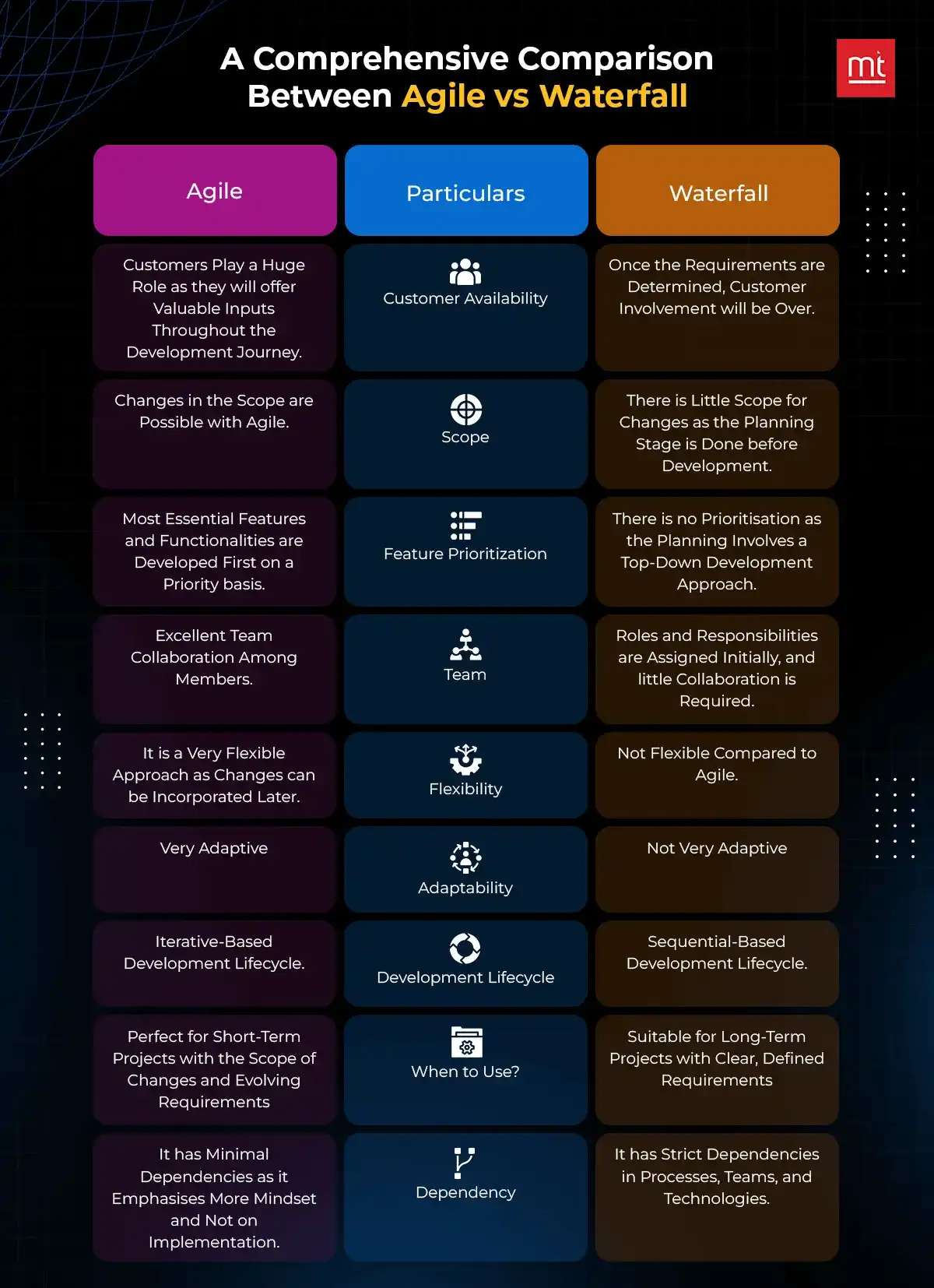
#1. Roles
In the Waterfall approach, each team member has pre-defined roles and responsibilities. They just need to perform the duties assigned to them.
On the other hand, the agile approach is more about collaboration among team members, with no pre-defined roles and responsibilities. It is a more streamlined approach, as a large group of people monitors various development aspects.
#2. Planning
The Waterfall approach has linear planning. Developers plan and strategize everything at the beginning of the process. Detailed documentation, such as tech stack, features, project goals, etc., is required to start the project.
The Agile approach is different. Here, planning is a continuous process throughout the development phase. New adjustments can be made as per the evolving requirements.
#3. Scope
In the waterfall approach, the project's scope is defined in the beginning and has not been changed. Changing the scope might increase costs and time.
On the contrary, the agile approach embraces changes in the scope at any level. Developers can easily adjust to these changes, and they will not impact costs.
#4. Timeframes
If it is a long-term project, the waterfall approach is the right one as it has different phases that depend on each other. The process is very linear and straightforward.
Agile has shorter timeframes as the whole project is divided into multiple sprints. Developers can adjust changes in the requirements and scope.
#5. Speed
The Waterfall approach might take more time than agile, as all the requirements must be made and agreed upon before the project starts.
Agile development follows iterative development cycles, delivering the product faster than Waterfall.
#6. Client Involvement
The client involvement is minimal with the Waterfall model. Once they have defined the end goals, the role of clients is finished. They don’t actively participate in the process.
On the other hand, the agile approach involves clients at each stage of the development life cycle. Developers get valuable feedback and suggestions from clients during each stage of the life cycle.
#7. Flexibility
When comparing the Agile vs. waterfall approach, the latter is less flexible. The Waterfall approach asks you to complete the first phase before moving to the next phase, which is less flexible than this linear approach.
Agile development allows developers to incorporate new information or updates even at the later stage of development, making it more flexible than Agile.
#8. Budget
In the Waterfall approach, the budget is fixed at the initial stage. Here, the project is determined as a whole, and no budget changes are made during the development phase.
Agile welcomes experiments throughout the development life cycle; hence, budgets cannot be pre-defined. The cost might change as you incorporate new features or functionalities at the latest stage of SLDC.
#9. Delivery
The agile approach wins in the delivery category, as developers find it easier to work on small sprints than a linear approach. Agile also has shorter lifecycles than Waterfall.
Waterfall restricts developers from working simultaneously on multiple phases. Developers cannot jump directly to the next phase before completing the current one. It makes the process time-consuming and longer.
#10. Documentation
Agile does not require extensive documentation, emphasizing self-organizing teams collaborating to deliver high-quality outcomes.
Conversely, a waterfall process requires extensive documentation to ensure all team members work according to their pre-defined roles.
#11. Testing
During Waterfall development is performed once the development phase is over. This might become time-consuming as developers find returning to earlier phases to identify and address issues and errors challenging.
In agile, testing is done simultaneously with development. Developers perform incremental testing to find and resolve issues during development.
#12. Focus
When you compare Agile vs Waterfall approach for focus: Waterfall focuses on products and processes. Here, the objective is achieved by going through step-by-step, pre-defined phases.
On the other hand, agile focuses more on client satisfaction and team collaboration by allowing various team members to collaborate on different development aspects.
When to Use Agile and Waterfall Methodologies?
You must know when to use Agile vs Waterfall approach. All the stakeholders must brainstorm and conclude. They must refer to project requirements, tech stack, scope, and other essential aspects before choosing the most suitable approach.
If your project has a linear and strict timeline and requirements, you must choose the Waterfall approach. On contrary, when you are working on a project that have evolving project requirements, you must choose Agile.
Also, if your project requires minimum client involvement, go for Waterfall. If the client wants to get involved at the each stage of the project development, go for Agile.
Conclusion
Do you want to build high-quality and user-centric software that helps generate high ROI? Which project management approach would work for you? When you compare Agile Vs. Waterfall has both pros and cons. It depends on your project requirements, scope, and other factors. You need to discuss it with your team to choose the most suitable software development approach that aligns with your business goals, project requirements, and other aspects.
For long-term projects with a linear timeline, Waterfall would be the best approach to go for. On the other hand, if you are working on a project with constantly evolving requirements, Agile would work for you.
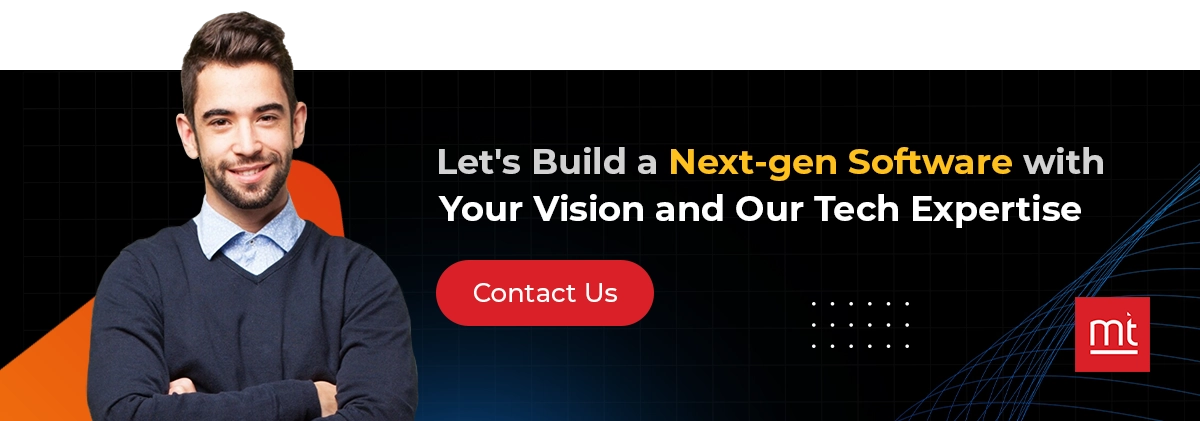
Subscribe to Our Newsletter!
Join us to stay updated with our latest blog updates, marketing tips, service tips, trends, news and announcements!


